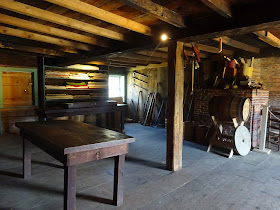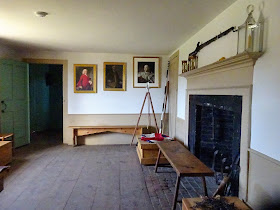We (my husband and I) began our Open House tour of the six-floor Boston Athenaeum by taking the elevator to the basement. When the door opened, we faced magnificent large-sized oak card catalogs. Since we're on our own self-guided tour of the library, I had to stop, because right in front of me were the drawers to the Ps. Yes, I found my Pooles, both of them, Charles Henry Poole and William Frederick Poole, both my 2nd great grandfathers. Their children married each other.
Both my 2nd great-grandfathers have material in the library. Charles H. Poole has one (above), and William Frederick Poole has 27 (below). All listings are at the end of this post.
On one of the upper floors, I found a set of William Frederick Poole's, Poole's Index to Periodical Literature volumes. The books are also seen below, just above the head on the lady on the right, up from the red books. This was not a new find to me, because I had seen them at the Boston Public Library around 1998.


The above picture was taken from the Athenaeum's web page in 2016, soon after I saw the above painting on exhibit at the Concord Museum in Concord, Massachusetts. Unfortunately, no photos were allowed there, so I inquired as to who owned it. I was told it belonged to the Athenaeum, and with that information, I found the above web page and knew I had to be patient because eventually, I'd see it.
During the open house last fall, I searched on every floor and quite by accident, as I walked by the closed darkened membership office on the first floor, there it was! I got to an employee as quick as I could and almost begged to see if she would open the door. She did and remained patient as I took quite a few pictures, turned on the office lights and looked out the window. Outside is the Granary Burying Ground, and this painting was done there by N. C. Wyeth, as he painted Louisa May Alcott's father Bronson Alcott reading a tombstone. Thanks to the cemetery stone in the foreground, with the two skeletons, I was able to find the stone rather easily. (The tree above, is also seen below.)
During the open house last fall, I searched on every floor and quite by accident, as I walked by the closed darkened membership office on the first floor, there it was! I got to an employee as quick as I could and almost begged to see if she would open the door. She did and remained patient as I took quite a few pictures, turned on the office lights and looked out the window. Outside is the Granary Burying Ground, and this painting was done there by N. C. Wyeth, as he painted Louisa May Alcott's father Bronson Alcott reading a tombstone. Thanks to the cemetery stone in the foreground, with the two skeletons, I was able to find the stone rather easily. (The tree above, is also seen below.)

In June 2016, I wrote, What Did Louisa May Alcott's Father Think About Genealogy? If you are curious, you might enjoy it. Below, is the cemetery stone in the above painting.

 From home, you can check their online catalog to see if you too have authors in your family. To do a basic search in the Athenaeum's online catalog, use this link:
From home, you can check their online catalog to see if you too have authors in your family. To do a basic search in the Athenaeum's online catalog, use this link:https://catalog.bostonathenaeum.org/vwebv/search?searchType=7&searchId=319&maxResultsPerPage=50&recCount=50&recPointer=0&resultPointer=4&headingId=902730
Just follow the directions. I had no problem getting my results, shown below.
An attempt towards a glossary of the archaic and provincial words of the county of Stafford /
- Main Author:Poole, Charles Henry.
- Title:An attempt towards a glossary of the archaic and provincial words
of the county of Stafford / first brought together by Charles Henry Poole, A.D. 1880. - Publishing Details:Stratford-Upon-Avon : Printed at Saint Gregory's Press, [1880]
- Description:28 p. ; 22 cm.
- Subjects:English language--Dialects--England--Staffordshire.






























